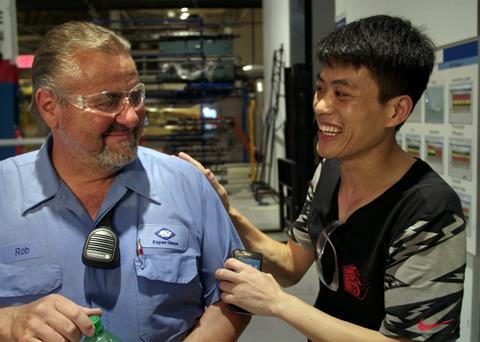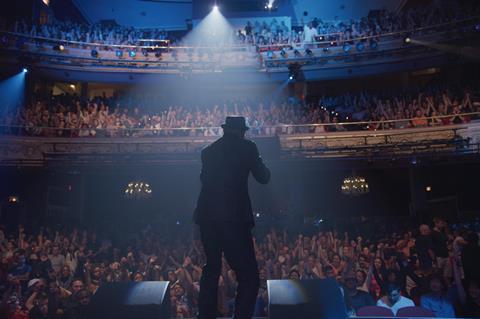Audience appetite for documentary features has never been greater and every platform, from theatrical to streaming, is jostling for a piece of the action. Screen explores some key themes in the whopping haul of titles competing for the attention of awards voters.
Ask documentary filmmakers about the current state of their business and the answers are universally upbeat. “This is a great time to be making documentaries, because there’s so much appetite for true stories told well,” says Rachel Lears, director of Sundance 2019 documentary audience award winner Knock Down The House, giving a typically bullish response.
The appetite is coming from theatrical distributors chasing the kind of success achieved by recent non-fiction hits such as Free Solo, which grossed $29m at cinemas worldwide; from legacy television networks such as HBO, National Geographic, CNN and Channel 4; and from streaming services, both established, like Netflix and Amazon, and new on the scene, like AppleTV+.
The result is a documentary feature field packed with films tackling diverse subject matters in an impressive range of styles — in fact a bumper 159 features were submitted for the category at the Oscars (which will be reduced to a shortlist of 15 titles, announced on December 16).
With a divisive figure in the White House, a US presidential election on the horizon and chaos in the corridors of power in a number of other countries, it is hardly surprising that politics has been one of the documentary genre’s big themes this year.
Lears’ Knock Down The House, which follows four women running as outsider candidates in the 2018 US midterm elections, is just one of the many films turning political turmoil into compelling viewing. The Edge Of Democracy, about the recent crisis in Brazil’s political system; The Great Hack, an examination of the Cambridge Analytica voter data scandal; The Kingmaker, about former Philippines first lady Imelda Marcos; and Citizen K, about an oligarch-turned-dissident in post-Soviet Russia, have all pulled back the curtain on the dark arts of power.
Lears sees the trend stemming in part from the sheer prevalence of political news. “It’s definitely that there are a lot of good political stories out there,” she says. “We’re living in a really volatile historical moment.”
In her own case, she says, after the 2016 US election that made Donald Trump president, “I wanted to find a project that contributed to the national conversation in the era of Trump. A story of people coming together from different backgrounds and different parts of the country. Not just a reaction to Trump, but a reaction to some of the underlying issues that the country’s been facing and that perhaps led to the election in the first place.”
The fact Knock Down The House was acquired in a reported $10m worldwide deal by Netflix (which also picked up The Edge Of Democracy and backed The Great Hack), and given a day-and-date streaming/theatrical launch, helped the cause, Lears suggests.
“It was a very populist release in that way,” says the director, explaining that the day-and-date opening made the film immediately accessible for community and educational screenings as part of an impact campaign. “The film was available to everybody at the same time.”
Affairs to remember

Politics in its broader sense is the backdrop for several awards contenders focusing on current affairs issues around the world: American Factory looks at globalisation through the lens of a newly opened Chinese-run manufacturing plant in the US Midwest; Channel 4’s For Sama and National Geographic’s The Cave both tell human stories unfolding in the midst of the Syrian civil war; and Advocate looks at the work of a Jewish-Israeli human rights lawyer who defends Palestinians.
Julia Reichert and Steven Bognar, the documentarians behind the Oscar-nominated short The Last Truck: Closing Of A GM Plant, live and work in the economically struggling town where their latest feature documentary American Factory is set. Reichert notes that the project’s bigger picture emerged only slowly.
“We didn’t go in with any sense of agenda,” Reichert explains. “We went in continuing our effort to follow the lives of people who had lost their jobs and their sense of the future. We didn’t see it as the bigger story it became for close to a year of filming. “The early days [of the new plant] were full of hope and curiosity, people really wanting to understand each other despite the language barrier. A year or two in, that changed a lot.”
Reichert and Bognar had early backing from Participant Media for what turned out to be the filmmakers’ most costly title to date. American Factory became the first feature released under Netflix’s deal with Higher Ground, the production company formed by Barack and Michelle Obama, which picked up the feature in association with Netflix at Sundance.
Bognar suggests that American Factory fitted in with the former president and first lady’s goal “to use the power of storytelling to bridge divides. We tried to make a film that had a lot of nuance and complexity to it and we feel like that’s the kind of storytelling the Higher Ground team want to support — storytelling in which you don’t have to agree with each other but everyone gets their voice.”
The hot-button issues of conservation and climate crisis figure to varying degrees in a number of this year’s acclaimed documentaries, among them The Biggest Little Farm, National Geographic’s Sea Of Shadows, Honeyland, Aquarela, When Lambs Become Lions and The Elephant Queen, the first feature documentary acquired by new streaming platform AppleTV+.
The Biggest Little Farm director John Chester posits that documentarians’ interest stems from recognition of the fears the issues raise, particularly in the generation that could be most affected. “We are hearing the voices of our children being as scared as we were when we were kids about nuclear war,” the filmmaker-turned-farmer says. “There has been so much fear about climate change and the human forces that have destroyed biodiversity, but there hasn’t been a real understanding of what an ecosystem is.”
Chester says his film, which tracks the eight-year struggle he and Molly Chester went through to establish a 200-acre California farm working in harmony with nature, “uses the microcosm of a farm to illustrate the greater ecosystem and how it works”. And audiences, who so far have driven the film to a $5m worldwide box-office take, “are finding tremendous hope in that”, says the director.
Sea Of Shadows, initially backed by Leonardo DiCaprio’s Appian Way, tells the broader story of a group of scientists, activists, journalists and undercover agents trying to save a nearly extinct species of whale in Mexico’s Sea of Cortez and being forced to battle local drug cartels and Chinese traffickers in the process.
Austrian director Richard Ladkani says he saw the events chronicled in the film as being “symbolic of so many other stories. We were trying to say that our planet is under attack and people don’t care because they’re all dealing with other issues.”
Yet at the same time, he notes, Sea Of Shadows “is very much like a real-world thriller, with these real-life James Bond characters risking their lives for the planet. That’s intriguing and has potential to appeal to a very big audience.”
With the rise of European green parties and movements such as Greta Thunberg’s Fridays for Future, “environmental stories about what’s happening with our planet have become much more mainstream”, Ladkani argues. “This is very marketable stuff right now.”
Historical events may lack that topical edge but remain an important hunting ground for filmmakers, providing material this year for CNN Films’ Apollo 11, documenting the 1969 moon landing mission; Amazon acquisition and Sundance documentary grand jury prize winner One Child Nation, about China’s birth control policies; Maiden, the story of the Whitbread round-the-world yacht race’s first all-female crew; Where’s My Roy Cohn?, a biography of the 20th-century political power broker; and The Apollo, HBO’s film about the famous Harlem theatre.
Apollo 11 director Todd Miller acknowledges that assembling his film entirely from archive material — including a newly discovered trove of 65mm footage covering the historic mission — was a risky move with uncertain commercial implications. But the move paid off, with the film having taken $12m to date at the global box office.
The theatrical run was made possible by CNN’s “very realistic” approach to windowing, says Miller, who suggests that making the film with a streaming service might have restricted Apollo 11 to the sort of shortened theatrical run given by Netflix to Martin Scorsese’s fiction feature The Irishman.
“That’s not a real release and that film deserves to be on the big screen,” Miller asserts. “A similar thing could have happened to our film and that would have robbed people of the experience of seeing it on a big screen, which is where this footage should ultimately live.”
The power of now

Roger Ross Williams, a governor of the Academy of Motion Pictures Arts and Sciences and chair of its documentary branch, took a different approach for his film, The Apollo. The director took archive footage of performers including James Brown, Aretha Franklin and Richard Pryor on the 85-year-old Apollo’s stage and combined it with contemporary interviews and scenes from the theatre’s 2018 stage adaptation of Ta-Nehisi Coates’ book Between The World And Me.
“I never wanted The Apollo to be a strictly archival film,” Williams explains of the project. “I always wanted it to be a political film about the power of music and art to lift black people out of oppression. It was important to connect it to the present day and what’s happening now in America.”
Including the current day material in the film, says Williams, “shows the Apollo is leading the way in the conversation of where we are as black people in this country”.
Highlighting the importance of the role played by music in black cultural history, The Apollo also takes its place in one of 2019’s other categories of notable documentaries. Among the year’s critically and commercially successful music-themed non-fiction outings are Pavarotti, Ron Howard’s portrait of the opera superstar, which has grossed $7.5m worldwide, and three films that have apparently struck a chord with baby boomer fans of 1960s and 1970s Los Angeles folk-rock: CNN’s Linda Ronstadt: The Sound Of My Voice; Echo In The Canyon, about the early days of the city’s vibrant Laurel Canyon scene; and David Crosby: Remember My Name.
Directors Rob Epstein and Jeffrey Friedman, documentary feature Oscar winners for Common Threads: Stories From The Quilt, suggest that while their film about Ronstadt’s exploration of different musical styles and eventual loss of voice to illness has music at its core, it also shares something with their previous non-music documentaries. “It didn’t feel unrelated to other work we’ve done,” says Friedman, “in that it’s the story of someone who created her own path and ultimately had a real effect on the culture.”
“We came to see her as a pioneer,” adds Epstein. “We were so taken by the way she always kept her humanity intact, even when she was a superstar.”
Linda Ronstadt: The Sound Of My Voice has so far taken $4.2m at the North American box office. Chiming in with his fellow documentarians, Epstein sees the multiplicity of documentary backers and the popularity of the genre with audiences as signs the documentary business is indeed thriving.
“It really feels like the golden age of documentary because there are so many more possibilities,” says Epstein. “All these [funding] entities are now in the documentary business, whereas before the choices were pretty limited.”


























No comments yet